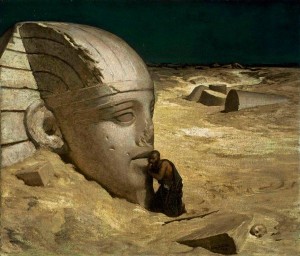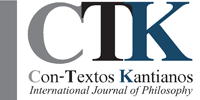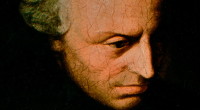Michail Minakov. Epistemological Significance of Faith: Kant’s notion of ‘Vernunftglaube’ and its Interpretations
Since the ‘divorce’ of philosophy and theology in early Modern Time, the both began to reassess each others’ subjects. Thus, philosophy ─ especially in the epoch of Enlightenment ─ became aware in its own way of problems connected with faith and beliefs. Pretty soon these subjects became an important issue for emerging epistemology in connection with the problem of knowledge and presuppositions of cognition.
Immanuel Kant was fully aware of this problem since it was an issue for the dogmatic and skeptic philosophies of his time. Instead of long tradition that interpreted knowledge and faith as opposite notions, he proposed quite a new way of dealing with the problem. In his Critical Philosophy Kant has identified certain place for human capacity of believing (Glaube, faith).
Kant’s approach to relations of faith and reason has denied the traditional metaphysical division of knowledge and faith. He mended the gap between two capacities of human spirit by understanding faith as legitimate and necessary part of reason. As he personally stated:
„Ich mußte // also das Wissen aufheben, um zum Glauben Platz zu bekommen, und // der Dogmatism der Metaphysik, d. i. das Vorurtheil, in ihr ohne Kritik // der reinen Vernunft fortzukommen, ist die wahre Quelle alles der Moralität // widerstreitenden Unglaubens, der jederzeit gar sehr dogmatisch ist.“ [9, B XXX].
In his ‘Critique of Pure Reason’ Kant argued that it is naturally for reason to un-contradictory know and believe. Although the reason and its ability to believe have a moral (i.e. practical) nature, the Vernunftglaube has an epistemological significance. In my book I identified at least 3 main functions of faith in thinking that Kant described in the first Critique. These functions are:
- regulatory function, i.e. when faith supports for a need of our mind to think towards certain final ─ approved by reason ─ aim;
- reason’s unity function, i.e. when theoretical reason accepts the fact of ‘doctrinal faith’ as one of the elements connecting it to the practical reason and explaining its dominance;
- performance function, i.e. when the theoretical reason accepts the fact of ‘pragmatic faith’ as an act of motivation for ideas to be performed [2, Chapter 2].
Analysis of ‘Glaube’ as a natural element of thinking and practicing (above its religious and moral contexts) made it possible for Kant to evolve the Enlightenment’s faith into the critical Vernunftglaube and propose a project of holistic view on Reason (Vernunft) as a unity of capacities.
The Kant’s radical concept of Vernuftglaube has been accepted mostly critically by his contemporaries. J.G. Hamann, F.H. Jakobi and T. Wienzenmann were the first to react on the notion of Vernunftglaube as a guard for religious faith. Since that time Kant’s notion was mostly condemned by religious philosophers for, I take it, illusionary ‘subordination of faith to moralty’.
Kant’s epistemological functions of faith were also condemned as ‘unnecessary adding to cognition’ from the side of speculative philosophers until late XIX. The both, religious and speculative philosophies approached to the concept as to a weak argument of Kant.
Still, with the raise of Neo-Kantian movement less ruining interpretations proposed to accept the Vernunftglaube as a challenge rather than unnecessary element of philosophy.
In the Russian philosophy this approach we may see in Vladimir Soloviov article ‘Faith, Reason and Experience’ containing an outline of his epistemological position [3]. Vladimir Soloviov agreed with the Kant’s idea of non-contradictory relations of faith and knowledge. However, his arguments were of different kind: he interpreted faith as ‘perfect cognitive act’. He stated that faith is an act of the truth cognition. This cognition still results with the knowledge, although this kind of knowledge has ‘higher value’ than the ‘empirical’ or ‘theoretical’ knowledge.
This was an attempt to fight materialists’ views on nature of knowledge. Soloviov has seen in Kant’s Vernunftglaube notion a possibility to rationally prove the faith’s epistemological significance. But later he found it himself as unsatisfactory attempt, since his position did not ruin the relative importance of the both ‘empirical’ and ‘theoretical’ knowledge
Alexander Vvedensky proposed another way of interpreting the Vernunftglaube in a series of articles dedicated to moral philosophy of Kant [1, с. 167]. Prof. Vvedensky addressed both materialism and mysticism in his Kantian meditations. His interpretations of Kant’s Vernunftglaube resulted with a new analysis of faith in its relation to experience and understanding.
Trying to identify how faith and reason may un-contradictory work together in cognition Vvedensky follows Kant. As Kant he creates a table of different types of faith, which has its perfect top with the type of ‘conscious intellectual faith (soznatelnaja intellectualnaja vera)’. This faith is an act of doubtless acceptance of certain knowledge that undergone through critical analysis. In accord with his understanding, the very critical philosophy is the state of equivocation of knowledge and faith, when knowledge becomes self-evident and faith becomes truly conscious. This way prof. Vvedensky tried to prove the importance of rational epistemology to religious philosophers who did not recognize significance of ‘relative’ knowledge based on reason.
These both attempts show the way traditional philosophy tried to positively interpret Kant’s radical notion of Vernunftglaube. But even later that concept challenged philosophers to clearly differentiate faith as element of moral/religious sphere, and faith as an element of epistemological system. Russian philosophers did not cope with that problem it staid open for a wile.
That problem was articulated once again in Strawson’s ‘Bounds of Sense’ [15]. Analytical approach of P. F. Strawson based on division of two parts in Kant’s system of transcendental idealism: positive (‘analytical argument’) and negative (‘transcendental psychology’). Among other statements, Sir Peter Strawson interpreted Kantian demand (directed to a philosopher) to have a rational faith as epistemological precondition of critical system [15, 86 ff.]. But this precondition is described as one with an openly psychological nature.
To defend the Kant’s views Stephen Palmquist argues in his brilliant ‘Kant’s System of Perspectives’ [11] that faith of reason is rather a mean to deal with Ding-an-sich, an extreme assumption that is based only on rational belief of reason. He once again shows that Kant did not see in faith any source of cognition; it was rather a ‘Vürwahrhalten’ (holding-to-be-true) of mind with itself being conscious of its incompleteness. The Vernunftglaube is a way a philosopher treats the poles of cognition (thin-in-itself and noumeno) for the sake of keeping in a whole the systemness of human thinking [11, 203 ff.].
This way Kantian interpretations are coming back to basic idea of Kant that Vernunftgaube is an important element of system of reason being a unique and systematic unity of thinking. The circle of interpretation comes back from the ‘problem of final knowledge that is equal by its undoubtfulness to a faith’ to assessment of types of preconditions of thinking.
That circle also demonstrates that epistemology ─ that is framed within bounds of ‘self-evidence/doubtfulness’ categories ─ domed to either analyze itself in terms of knowledge and faith, or rearticulate its categories in a way that would let use those terms that have a clearly different concepts for different spheres of philosophical analysis.
Bibliography
1. Введенский А.И. Статьи по философии. СПб.: Изд-во С.-Петерб. ун-та, 1996.
2. Мінаков М. Вчення Канта про віру розуму. Київ: Центр практичної філософії, 2001.
3. Соловьев В.С. Вера, разум и опыт (1877) // Вопросы философии. 1994. № 1.
4. Allison H.E. Transcendental Idealism and Descriptive Metaphysics // Kant-Studien. 1969. № 60. С. 216—233.
5. Böhme H., Böhme G. Das Andere der Vernunft. Frankfurt am Main: Suhrkamp, 1985.
6. Hamann J.G. Vom Magus im Norden und der Verwegenheit des Geistes. Bonn: Parerga, 1993.
7. Heimsoth H. Personlichkeitsbewustsein und Ding an sich in der Kantischen Philosophie// Konigsberger Kant-Festschrift. 1912. № 1. С. 3—40.
8. Jakobi F. H. Über die Lehre des Spinoza. Hamburg:V. Meiner Verlag, 2000.
9. Kant I. Kritik der reinen Vernuft (1787) // Gesammelte Schriften (Akademie-Ausgabe). B. 3. Berlin: de Gruyter Verlag, 1968.
10. Michelson G.F. The Historical Dimension of a Rational Faith. Washington: DCC, 1977.
11. Palmquist S. Kant’s System of Perspectives. Lanham, MD:UPA, 1993.
12. Palmquist S.R. Immanuel Kant: a Christian Philosopher // Faith and Philosophy, 1989. № 1. P. 65—75.
13. Palmquist S.R. Does Kant reduce Religion to Morality? // Kant-Studien. 1992. № 2. S. 129—148.
14. Sänger E. Kants Lehre vom Glauben. Leipzig: Duerr’schen Verlag, 1903.
15. Strawson P. F. The Bounds of Sense. London: Routledge, 1999.
16. Wood A. Kant’s Moral Religion. Cambridge, London: Cambridge University Press, 1970.
This article was firstly published in collected articles “Kant zwischen West und Ost” (2005):
Minakov, Michail. Epistemological Significance of Faith: Kant’s notion of ‘Vernunftglaube’ and its Interpretations// Kant zwischen West und Ost. Zum Gedenken an Kants 200. Todestag und 280. Geburtstag. Hrsg. Von Prof. Dr. Wladimir Bryuschinkin. Bd.2. Kaliningrad, 2005. P.250-254.





